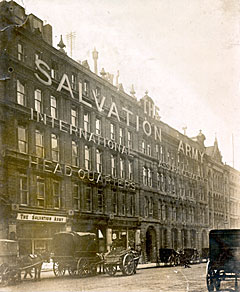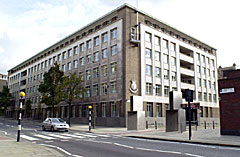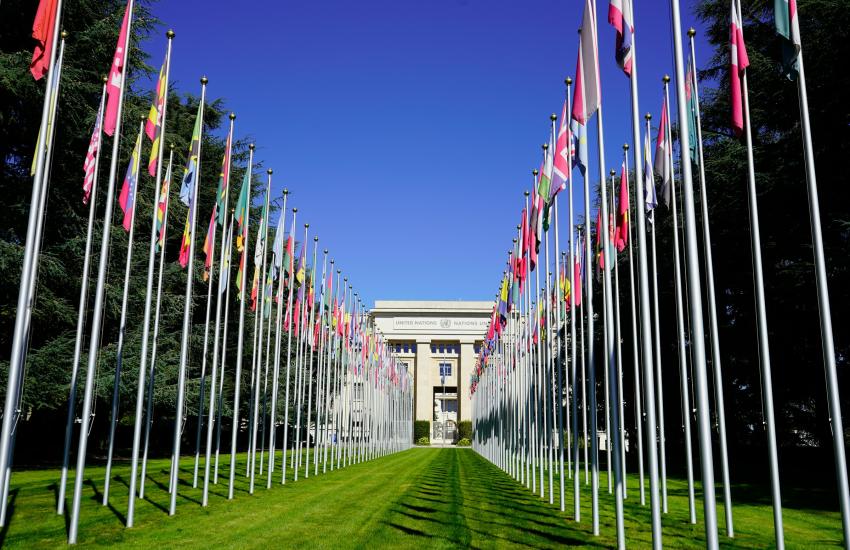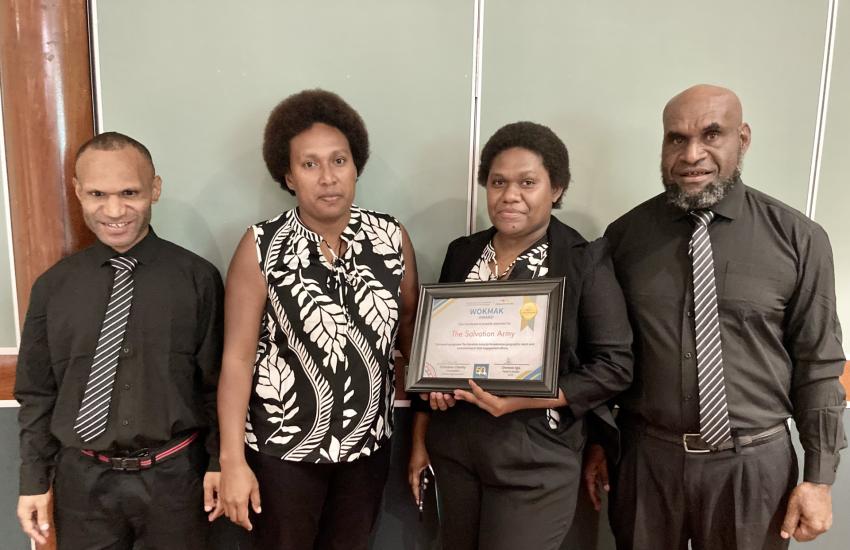The history of 101 after William Booth took the Army there in 1881 is well documented, but that is less true of the centuries before. The two recent redevelopments on the 101 site have afforded the opportunity to delve more deeply into the past, with archaeological digs revealing the site’s varied history.
During the construction of the 1963 building a graveyard was unearthed, apparently belonging to a church of St Peter and St Paul the Lesser, erected in the 12th century. Further investigations carried out by Pre-Construct Archaeology Ltd (PCA) between 2001 and 2003 revealed evidence of massive Roman foundations from a possible temple complex, medieval road surfaces which were later fused by the 1666 Great Fire of London, and a couple of ale houses – at least one of which did its brewing on-site.
The earliest evidence of occupation comes from first-century Roman London, when the bank of the Thames would have been a full 50 metres further north than today. Oak timbers discovered seem likely to have come from a waterfront structure and warehouse. Land was later reclaimed along the foreshore, and excavations revealed a wall with two apses – from a large building or simply as the locations for riverside altars – constructed in the mid second century. A further redevelopment in the third century was, apparently, never completed.
The site was abandoned after the Romans left and it wasn’t until the 13th century that metalled road surfaces of Thames Street and Lambeth Hill were established. Four phases of road surfaces were discovered, along with finds that reflect the hustle and bustle of a busy street. At some point it seems there was also a wealthy household on the site.
A brick building constructed in the early 17th century was destroyed in the 1666 Great Fire of London. The remains of an addition which would have housed a large vat, together with the remains of burnt barley grains, suggest that it was an ale house which brewed its own ale.
The ale house was not replaced until the late 1700s, when a brick building was constructed. A clay tobacco pipe found on the site stamped with the name of a pub on Upper Thames Street suggests that this replacement building was also a drinking venue.
More-recent history is easier to ascertain – the building which became The Salvation Army’s International Headquarters in 1881 was a billiards hall that had been built with the construction of the relatively new Queen Victoria Street.
As the site today of a building occupied by a Christian Movement that advocates teetotalism, there’s a rich irony that 101 Queen Victoria Street has spent the best part of the last 2,000 years going from being a place of worship to a place to get drunk – and back again! The Founder, William Booth, would surely be pleased to know that even the International Headquarters site has been saved from a life of squalour!
Simple needs
The needs of The Salvation Army weren’t always as complicated as today. In his early preaching days, almost the only requirement of The Salvation Army’s Founder, William Booth, was a hired meeting hall. In fact his first meetings took place in the street. They then moved to a tent on a disused Quaker burial ground. In 1867 Booth purchased a former public house, called the Eastern Star, turning it into the headquarters of the then East London Christian Mission.
Two years later, the Christian Mission took over the People’s Market at 272 Whitechapel Road for use as a place of worship, headquarters offices and a cheap food shop for the poor. Those premises were still the headquarters in 1878 when the final name change took place, to The Salvation Army.
The Movement grew at a phenomenal rate and William Booth, with his son – and Chief of the Staff – Bramwell, was aware of a need for more suitable and spacious accommodation. They came upon 101 Queen Victoria Street while returning from a business call. Seeing signs advertising ‘These desirable premises to let’, Bramwell was struck immediately. ‘There’s our new headquarters!’ he exclaimed. A quick ‘peep through the door’ confirmed things: this old billiards club had everything The Salvation Army needed. There was no time to waste.
 Booth knew exactly where to go: to T. A. Denny – via the Whitechapel offices, where he gathered his staff and told them to pray about the matter. T. A. Denny was a generous benefactor but he outdid himself by offering to pay the first year’s rent. Success! The official date that 101 Queen Victoria Street became the headquarters of The Salvation Army was 8 September 1881.
Booth knew exactly where to go: to T. A. Denny – via the Whitechapel offices, where he gathered his staff and told them to pray about the matter. T. A. Denny was a generous benefactor but he outdid himself by offering to pay the first year’s rent. Success! The official date that 101 Queen Victoria Street became the headquarters of The Salvation Army was 8 September 1881.
As with the move to today’s 101, no formal ceremony took place until two weeks after the move, when Booth himself held a noonday prayer meeting to give thanks to God for the provision.
Ten years later, thanks to the generosity of a Scottish friend, Mrs Elisabeth Orr Bell, The Salvation Army bought the freehold of the site for £70,000 – equivalent to around £5 million today.
When The Salvation Army first moved to 101 Queen Victoria Street, in 1881, it took two trips in a fruiterer’s horse-drawn van and a handcart. Halfway to the new City offices one of the wheels fell off the handcart. Cadet William Whattam attempted to fix it, while his colleague, another cadet known as ‘Zulu George’, held off the roughs by threatening them with the flagpole that formed part of the precious cargo. The rest of the journey was made on one wheel, with one perspiring cadet pushing and the other holding the handcart on the wheel-less side.
Now, of course, it is a vastly different world. Lorries and lifts take the strain. Things move at the touch of a button, messages cross the earth in the blink of an eye. But something of the spirit of those two young men remains at 101 Queen Victoria Street – something of their effort, determination and teamwork, their steadfast belief – qualities given strength by the love of God.
Perhaps today’s International Headquarters staff would do well on occasion to look through the transparent walls down to the street below, and think of that cart, arriving for the first time, and the spirit that drove it. Combined with today’s opportunities, only the Lord knows where that spirit will lead next.
Bombs and builders
 On 11 May 1941 a devastating air raid took place over London and the subsequent fire destroyed the original 101 building. It would be 22 years until its successor was opened. First came the small matter of raising �1,125,000 to fund it. The reconstruction of the City had one outcome that directly affects this building, and that was the creation of a vista from St Paul’s Cathedral to the river, cutting right through the blitzed areas of the site. International Headquarters was faced with having two wings, one either side of the walkway. This did not appeal to the Army, and an agreement was negotiated whereby the site for the building was shifted eastwards, incorporating numbers 97 and 99.
On 11 May 1941 a devastating air raid took place over London and the subsequent fire destroyed the original 101 building. It would be 22 years until its successor was opened. First came the small matter of raising �1,125,000 to fund it. The reconstruction of the City had one outcome that directly affects this building, and that was the creation of a vista from St Paul’s Cathedral to the river, cutting right through the blitzed areas of the site. International Headquarters was faced with having two wings, one either side of the walkway. This did not appeal to the Army, and an agreement was negotiated whereby the site for the building was shifted eastwards, incorporating numbers 97 and 99.
In 1955 Messrs Lidbetter were appointed architects to design and supervise the construction of the new headquarters. Building work began in 1961 and, in November 1963, the new 101 was opened by Her Majesty Queen Elizabeth the Queen Mother. The building was shared by International Headquarters and the then British Territory, each of which was provided with its own entrance.
The previous 101 was very much a building of its time. The changes between the requirements of 1963 and 2004 couldn’t be more marked. The bright, open-plan layout of today is very different to the compartmentalised design of yesterday and there was no common space for interaction. Today the General is in full view of staff and public alike but, in the 1963 building, the General was removed from his people by a long, extremely private and, to some, forbidding corridor!
International Headquarters





